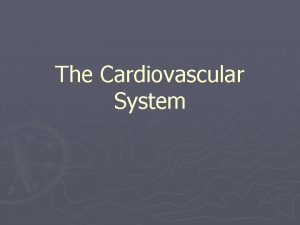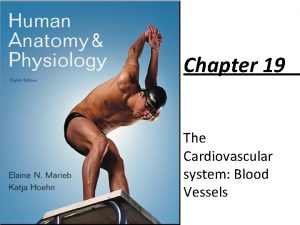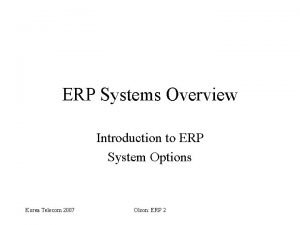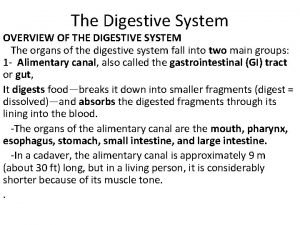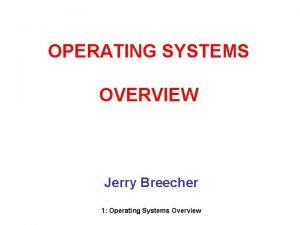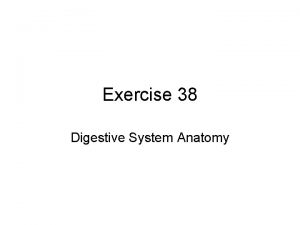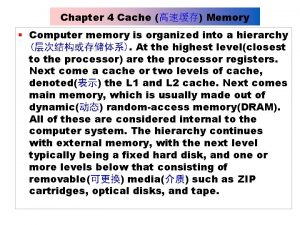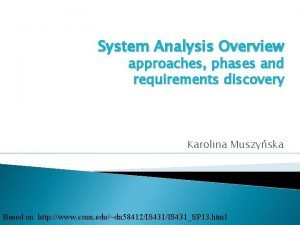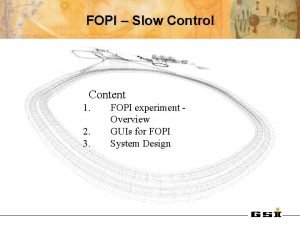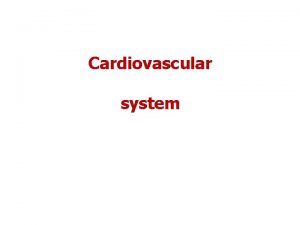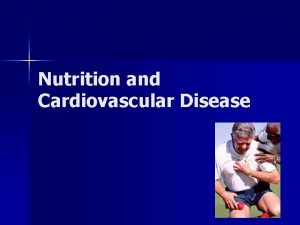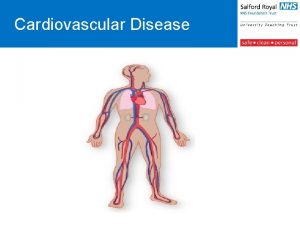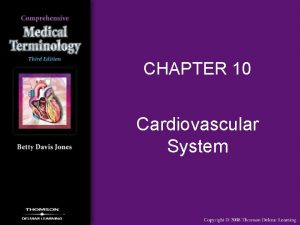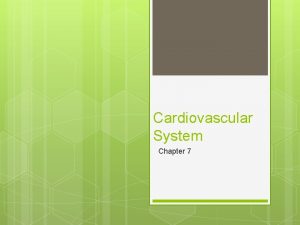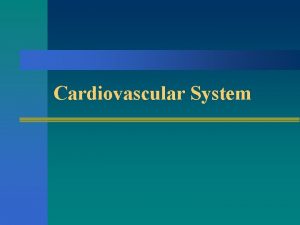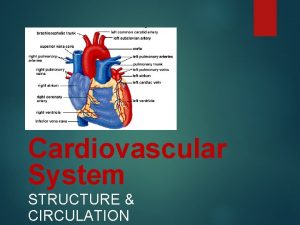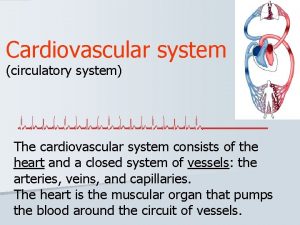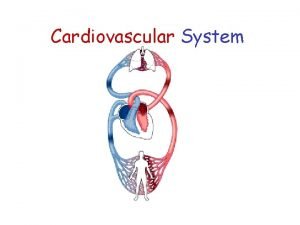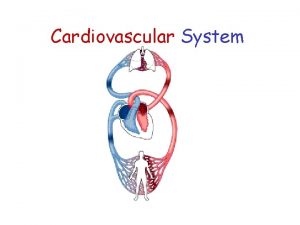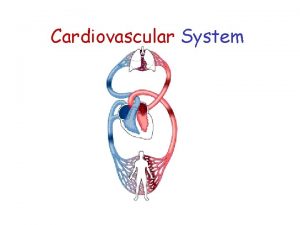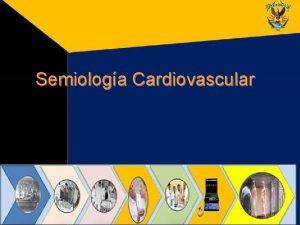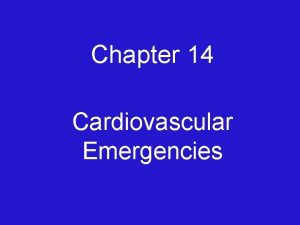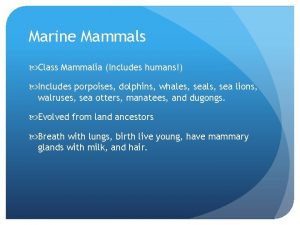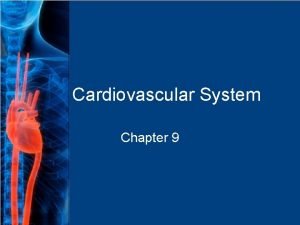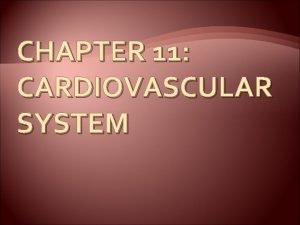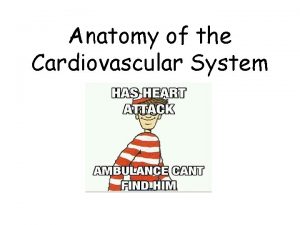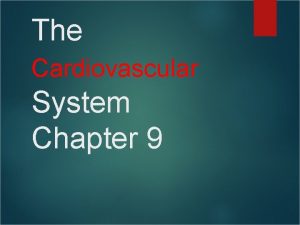The Cardiovascular System Overview The cardiovascular system includes



































- Slides: 35

The Cardiovascular System

Overview ► The cardiovascular system includes the heart, which is the pump that circulates blood, and the blood vessels, the highways that carry blood up and down the body.

The anatomy of the heart ► The heart is hollow, about the size of your fist, and divided into four main parts: Left atrium, right atrium, left ventricle, and right ventricle. ► The heart is located in the thoracic cavity.

Friction ► As any two objects rub against each other, they cause friction. To help solve that problem we have the pericardium. ► The pericardium is a serous sac that covers the heart. This sac allows the heart to pump with little resistance.

The heart itself ► The heart contains three different layers of tissue: the endocardium, the myocardium, and the epicardium.

Epicardium ► The epicardium is the outermost layer of the heart. It is a serous membrane that acts to reduce friction. There is adipose tissue found around the coronary artery and the cardiac veins.

The myocardium ► Thick middle layer of the heart. ► Rough and tough, has a large supply of capillaries that carry blood and other nutrients to this tissue.

endocardium ► Consists of epithelial tissue and connective tissue. ► Contains blood vessels and specialized purkinje fibers (detects cardiac impulses in the A-V bundle).

The chambers and valves of the heart ► The upper two chambers of the heart are called the atria. ► The lower two chambers of the heart are called the ventricles. ► Separating the left atrium and ventricle from the right ones is a solid mass of tissue called the septum. It prevents blood on the left side of the heart from mixing with blood from the right side.

Septum

Atrium/ventricle separation The tricuspid ► On the right side of the heart lies the tricuspid, a three sided valve that prevents the blood that is pumped from the right atrium to the right ventricle from coming back into the right atrium.

Mitral valve ► Like the tricuspid, the mitral valve prevents blood from flowing backwards after the atrium contracts. ► The mitral valve, also called the bicuspid, is located between the left atrium and left ventricle. ► The mitral valve contains two flaps instead of three.

Pulmonary Valve ► Another tricuspid shaped valve that is located at the base of the pulmonary artery. ► Just like the other valves, it prevents the blood from “backwashing” into the heart.

AORTA! ► The aorta is the largest artery in the entire body. At around one inch in diameter, it can pump a massive amount of blood. ► The first two arteries that branch from the aorta are the left and right coronary arteries.

Path of blood through the heart ► 1. Blood enters the right atrium through the vena cava. ► 2. Right atrial wall contracts forcing blood through the tricuspid valve and into the right ventricle. ► 3. As the right ventricle contracts, blood is forced through the pulmonary valve into the pulmonary arteries.

► 4. Blood exits pulmonary arteries and enters the capillaries in the alveoli of the lungs. Gas exchange occurs, and the blood now is rich in oxygen. ► 5. Blood leaves the capillaries and enters in the pulmonary veins. ► 6. After passing down the pulmonary vein, blood reaches the left atrium.

► 7. When the left atrial wall contracts, it forces blood through the mitral valve and into the left ventricle. ► 8. As the left ventricle contracts, the blood is forced through the aortic valve into the aorta where it travels throughout the body.


Listening to the heart ► When hearing the heart beat in a stethoscope, the louder first noise that is heard is called ventricular contraction. That is when the ventricles force the blood inside them out through their respective arteries. ► The second noise is ventricular relaxation. At this point the blood in the atrium is forced into the relaxed ventricle during that atrium’s contraction.

When to beat ► In the heart, there are specialized tissues that are designed to let certain parts of the heart know when to contract. These tissues comprise what is known as the cardiac conduction system. ► The sinoatrial node is a bundle of such tissue found at the top of the right atrium by the superior vena cava.

► The S-A node fires regularly 70 to 80 times per minute. ► Another name for the S -A node is the pacemaker.

► The impulse does not go directly through the heart. It travels down specialized cardiac muscle to the atrioventricular node. ► That signal that is received by the A-V node and spread throughout the heart by the purkinje fibers.

Blood Vessels ► The blood vessels act as the highway that blood travels. The arteries act as one lane, the veins as the other, and the capillaries as their off ramps.

Arteries ► Strong and very elastic. ► Arteries are designed to take the force of the blood pushing through them. ► As they get smaller and smaller, they are referred to as arterioles.

Inside the artery ► The inner layer of the artery is called the tunica interna, which is composed of simple squamous cells. (single layer of flat cells) ► Surrounding the tunica interna is a layer of connective tissue. On top of that is tunica media which is the thickest part of the artery. ► On top of that is the tunica extera which is another thin layer of connective tissue.

Vasoconstriction and vasodilation ► Vasoconstriction- When the muscle fibers in the artery contract, lessening the blood flow. (Good when cold) ► Vasodilation- When the muscle fibers relax, increasing blood flow. (Good during a heart attack)

Veins Carry blood back to the atria. ► The vein is built similar to the artery, however the tunica media is very under developed. ► Less tissue means a greater lumen (opening where the blood flows) ► Smaller veins are called veinules. ►

Preventing backwash ► Most veins contain these valve-like flaps on them that once blood is forced through them, they collapse and prevent blood from flowing backwards.

Capillaries ► Smallest blood vessels of all. ► Consists only of endothelium tissue. ► There are very tiny slits in the capillaries that allow for gas and nutrient exchange between the endothelial cells. ► Oxygen and nutrient rich blood cells will give away their nutrients and oxygen while picking up NH 3 and CO 2.

Blood Pressure ► Systolic BP- The first number in a blood pressure reading is the systolic blood pressure. This measures the amount of force that is thrust against the arteries during ventricular contraction. ► Diastolic BP- the second number in a blood pressure reading is the diastolic BP. This measures the amount of pressure in the arteries after the ventricular contraction.

► Normal Systole- 110 -120 § Normal high- 139 -149 § High- 150 + ► Normal diastole- 70 -80 § Normal high- 90 -109 § High- 110+ ► Normal Reading = 120/80 ► High BP= 150/120

Paths of blood circulation ► Pulmonary circuitblood circulation from the heart to the lungs. ► Systemic circuit- blood circulation from the heart to every where else in the body.

Major arteries ► Coronary arteries- first arteries to branch off of the aorta. ► Femoral arteries- runs down inside of thighs. ► Carotid artery- runs up the neck. ► Renal arteries- runs to the kidneys. ► Axillary arteries- runs to the arms. ► Illiac arteries- runs to the legs. ► Aorta- largest artery, takes blood from heart.

Major veins ► Axillary veins- leads back from arms ► Femoral veins- leads back from the legs ► Renal veins- leads back from kidneys ► Superior vena cava- draws blood back from upper half of body. ► Inferior vena cava- draws blood back from lower half of the body.

Questions?
 The cardiovascular system includes the
The cardiovascular system includes the Venous blood
Venous blood What makes up the cardiovascular system
What makes up the cardiovascular system Pithed rat meaning
Pithed rat meaning Its tubular dude
Its tubular dude Crash course cardiovascular system
Crash course cardiovascular system Cengage chapter 5
Cengage chapter 5 Chapter 11 the cardiovascular system figure 11-3
Chapter 11 the cardiovascular system figure 11-3 Figure 11-12 is a diagram of a capillary bed
Figure 11-12 is a diagram of a capillary bed Chapter 11 the cardiovascular system
Chapter 11 the cardiovascular system Lesson 11 cardiovascular system
Lesson 11 cardiovascular system Agranulocytes
Agranulocytes Hypertensive atherosclerotic cardiovascular disease
Hypertensive atherosclerotic cardiovascular disease Introduction of cardiovascular system
Introduction of cardiovascular system Ptca
Ptca Anatomy and physiology unit 7 cardiovascular system
Anatomy and physiology unit 7 cardiovascular system Chapter 8 cardiovascular system
Chapter 8 cardiovascular system Chapter 13 cardiovascular system
Chapter 13 cardiovascular system Chapter 11 the cardiovascular system figure 11-2
Chapter 11 the cardiovascular system figure 11-2 Major arteries
Major arteries True capillaries
True capillaries Erp system overview
Erp system overview Content management system capabilities
Content management system capabilities Introduction of computerised accounting
Introduction of computerised accounting Ductus parotideus
Ductus parotideus Sap easy cost planning
Sap easy cost planning Operating system overview
Operating system overview Gym introduction
Gym introduction Exercise 38
Exercise 38 Computer memory system overview
Computer memory system overview Computer memory system overview
Computer memory system overview British school system presentation
British school system presentation Financial intermediaries
Financial intermediaries British school system overview
British school system overview System design
System design System design overview
System design overview
